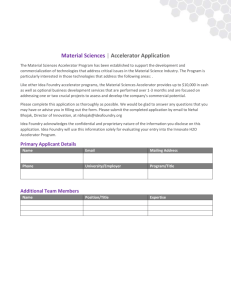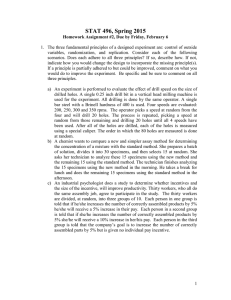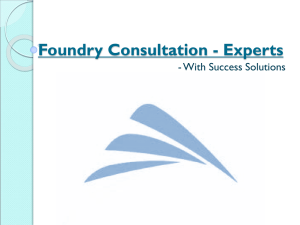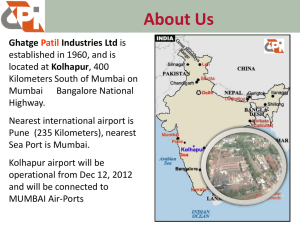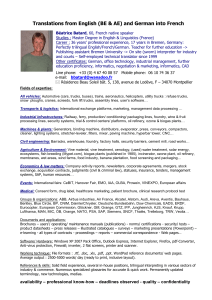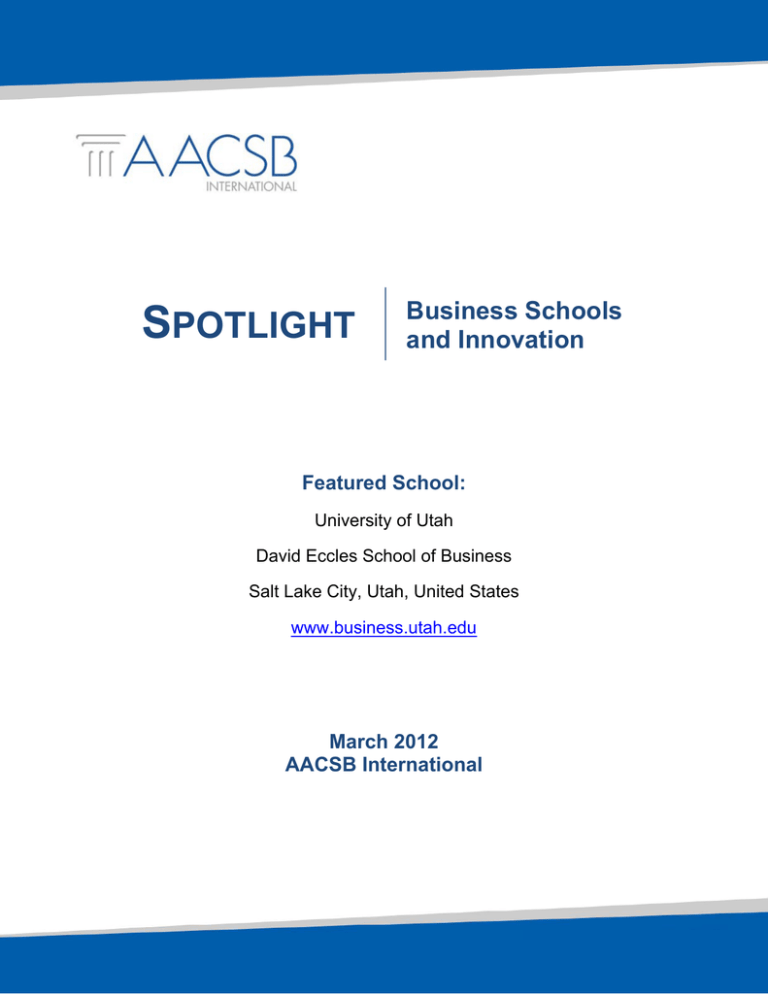
SPOTLIGHT
Business Schools
and Innovation
Featured School:
University of Utah
David Eccles School of Business
Salt Lake City, Utah, United States
www.business.utah.edu
March 2012
AACSB International
SPOTLIGHT | Business Schools & Innovation
University of Utah | 2
The Foundry
The report of the AACSB International Task Force on Business Schools and Innovation, Business School
on an Innovation Mission, acknowledges the role of entrepreneurship in the development of innovation in
business, and highlights the enormous opportunity for business schools to contribute to this vitally
important aspect of the economy.1 The David Eccles School of Business at the University of Utah has
taken to heart this prerogative of business schools to contribute to innovation with an inexpensive, highly
imitable and successful new model for business incubation that they have dubbed The Foundry.2
The Foundry Concept
According to the Department Chair, Professor Bill Schulze, the idea for this novel concept in business
incubation began as a follow-up to revamping the undergraduate entrepreneurship curriculum at the
Eccles School. He and his colleague Dr. Rob Wuebker, the Academic Director of the Foundry, were
working to give the undergraduate entrepreneurship curriculum greater emphasis on “doing and taking
action.” They felt that their students should be able to have actual experience in the entrepreneurial
process. Professor Schulze says that their hypothesis was that there are two reasons that talented people
create businesses that fail. The first is that they lack the knowledge and experience in self-management
required for business success. The second, and most important, is that they fail to rigorously test their
business concept (a process Professor Schulze and Dr. Wuebker call “business concept validation”)
before launch.
Based on this working theory, they began the Foundry as an incubator, with approximately 40 students in
the first cohort (F1). Participants in the Foundry’s program do not have to be students at the Eccles
School, or the University of Utah, or even students at all. Professor Schulze says that the initial idea
behind throwing the doors open to the general public was to build excitement about the program, by
offering it as a “pay-it-forward” measure to promote innovation in and for the greater Salt Lake
community.
Rather than treating the Foundry as a standard classroom with a teacher-to-student pedagogical
approach, however, they felt that the students would get more out of a peer-focused learning
environment. Professor Schulze characterizes the role of the Foundry team as that of “organizers, not
lecturers.” Unlike other incubators that focus on direct instruction from professors and/or guest speakers,
or on helping budding entrepreneurs to secure resources or launch companies, the Foundry concept is
built around the process of “Venture Discovery,” or the peer-led validation of the business concepts of the
participants.
© AACSB International. All Rights Reserved.
SPOTLIGHT | Business Schools & Innovation
University of Utah | 3
The Foundry Process
The Foundry team endeavors to select applicants with interesting ideas which will make solid foundations
for learning, according to Professor Schulze. He quips that whether or not the ideas are actually any good
is a secondary consideration. This is because the ability to recognize the need to start over when an idea
is not viable is a critical part of the learning experience for entrepreneurs. Most participants with such
ideas tend to recognize this by the fifth or sixth week of the program, he says, and subsequently adapt
them, begin again with new ones, or aid other participants with theirs.
The curriculum of the Foundry has three critical elements, or what Professor Schulze refers to as the
“three legs” of the program. The first such element is a series of 15 weekly meetings, in which the
participants divide into small, self-selecting teams to discuss and rigorously validate their business
concepts. As the program progresses, the students are required to take more and more responsibility for
the running of the meetings, with the eventual goal of becoming self-sustaining without direct faculty
involvement.
Participants are required to meet for one hour each Monday morning at 7:00 AM, local time. Twenty-four
hours prior to each meeting, the participants are required to file weekly management reports, so the other
members of their team will have time to read them before the meeting. The reports are filed using a
simple but robust managerial reporting system patterned after that used by Oracle. The two elements of
the reporting systems are the MOKR (Mission, Objective, and Key Results), and the weekly management
report. The MOKR outlines the participants’ objectives, and is used as the application form for the
program. The weekly management reports document their progress toward achieving those goals.
Specifically, the management reports cover each individual participant’s activities over the past week, the
status of their goals, and a statement of any obstacles or problems with which they would like to receive
help or advice from their team. These documents are carefully monitored by Foundry Director Wuebker.
The weekly meetings help Foundry participants develop the skills they will need to succeed in
entrepreneurial ventures in several ways. Professor Wuebker notes that working peer-to-peer to solve the
problems outlined in the weekly MOKR reports develops the collaborative techniques necessary to
business dealings. Articulating their weekly activities with their team forces participants to continuously
evaluate potential risks, as well as what they need to know or do to see if their concept will work in
practice. Professor Wuebker says that as the MOKR reporting process becomes iterative over time for
each student, it allows them to prioritize their questions and work to answer them week-to-week, while
becoming better and more disciplined managers through the repetition of the process. The participant
teams gradually turn into a support network through the shared experience, building the community of
entrepreneurs.
© AACSB International. All Rights Reserved.
SPOTLIGHT | Business Schools & Innovation
University of Utah | 4
In addition to the weekly Monday morning meetings, participants are expected to attend several two-hour
networking sessions, held on six Wednesday evenings throughout the program. These sessions often
feature guest speakers from among the entrepreneur community, and according to Professor Schulze
have included Foundry alumni in the past. In addition to the weekly meetings and the guest speakers,
teams also participate in monthly project reviews in front of a panel that includes Professor Wuebker and
a number of local entrepreneurs considered to be expert in the areas being explored by the presenting
team. Professor Schulze says that the students have reported finding these reviews extremely important
and helpful, in part because the format mirrors the type of presentations essential when speaking with
future funding prospects. The local entrepreneurs who participate in those reviews also frequently
become mentors for those students.
The second “leg” of the Foundry’s curriculum takes the form of a dedicated YouTube Channel, the
“USparkFoundryTV Channel,” which is used to deliver additional educational content. Since the weekly
meetings are dedicated to the discussion of the current challenges the students face, the Foundry makes
over 150 three- to eight-minute video-recorded sessions on entrepreneurial topics available to
participants (and the general public) for viewing at need.3 This allows for “just-in-time” answers to
participant questions that arise in between meetings. Professor Schulze says the YouTube videos receive
between 10-15,000 views per month.
The third critical element of the program is the suite of on-line resources made available by the Foundry
to facilitate networking and communication by the participants. In addition to social media such as Twitter
and Facebook (https://www.facebook.com/usparkfoundry), the Foundry coordinates its students’ use of
free online services such as Dropbox, Google docs, and Jive (a virtual PBX system); as well as offering
them free use of two fee-based services: Salesforce.com and QuickBooks. The Foundry holds a sitelicense for the fee-based services, and insists that students who are working with prospective customers
and/or marketing products use these services while affiliated with the Foundry, to better manage risk.
Professor Schulze argues that the Foundry’s peer-focused learning model, and the network of
entrepreneurial alumni that it builds, is also the reason that the incubator is sustainable. Even though the
school offers all services of the Foundry free of charge to all comers, the model actually requires very few
resources beyond providing a place for the participants to meet, and a structure for their activities.
Professor Schulze says that the school spent less than 14,000 USD to send the F1 cohort through the
program, most of which was spent on speaker travel and networking events. The School has since hired
a part-time director, and occupies office space that was donated to them by the City of Salt Lake. The
impact on the Salt Lake community, however, is greatly multiplied due to the fact that the Foundry
essentially trains its students to be serial entrepreneurs, and several have gone on to become just that.
© AACSB International. All Rights Reserved.
SPOTLIGHT | Business Schools & Innovation
University of Utah | 5
The Foundry Impact
The results thus far appear to bear out the Foundry concept. Since the launch of the F1 cohort in May of
2010, “three groups of students have examined 114 ideas, rigorously tested 69 business concepts, and
launched 56 companies. As of September, 2011, 43 remain active and Foundry companies have
cumulatively generated more than [4 million USD] in revenue and created more than 50 jobs.”4 According
to Professor Schulze, 22 of the active companies are already revenue positive, and some of those that
are no longer active, are so due to acquisition. The fourth Foundry cohort (F4) has launched as of
January 2012. Also in January 2012, the United States Association of Small Business and
Entrepreneurship (USASBE) recognized the Foundry for innovation in entrepreneurship education by
singling it out a prestigious award and “Special Recognition for Innovation in Entrepreneurship
Education.”
Since the Foundry concept is both low-cost and easily transferable, the Eccles School has begun to
export the idea to other institutions. Professor Schulze says that several other universities have
expressed interest in the concept, both in the U.S. and abroad. New York-based Rensselaer Polytechnic
Institute’s Lally School of Management & Technology, for example, has recently announced the opening
of their version of the Foundry,5 and George Mason and Utah Valley State Universities have each begun
one as well. A number of other universities, both within and outside the U.S., have contacted Professor
Wuebker for advice on launching their own versions of a Foundry program. The Salt Lake City-based
non-profit organization Women Empowerment Global Outreach (WEGO) has also employed the Foundry
model for an intensive 5-day training session for female entrepreneurs in collaboration with the IAB
Centre of Yerevan, Armenia.6
Acknowledgements: AACSB International is grateful for the assistance of Dr. William Schulze, Chair of
the Department of Management at the David Eccles School of Business and Professor Robert Wuebker,
Academic Director of the Foundry.
© AACSB International. All Rights Reserved.
SPOTLIGHT | Business Schools & Innovation
University of Utah | 6
End Notes
1
AACSB International. (2010) Business Schools on an Innovation Mission: Report of the AACSB International Task Force on Business Schools and Innovation. Electronic document, http://www.aacsb.edu/resources/innovation/business‐schools‐on‐an‐innovation‐mission.pdf, accessed January 17, 2012. 2
The Foundry. (2012) The Foundry web page. Electronic document, http://foundryutah.com, accessed January 17, 2012. 3
The Foundry. (2012) Foundry YouTube Channel video‐recorded sessions. Electronic documents, http://www.youtube.com/user/USparkFoundryTV, accessed January 19, 2012. 4
Cornwall, Jeff, ed. (2011) “Program Forges Student Ventures.” The Entrepreneurship Educator, October 30, 2011. Electronic document, http://www.icsb.org/article.asp?messageID=809, accessed January 18, 2012. 5
Rensselaer Polytechnic Institute. (2012) “Severino Center Launches Foundry‐RPI.” Lally School of Management & Technology Press Release, January 11, 2012. Electronic document, http://lallyschool.rpi.edu/news/2012/011112.foundry.html, accessed January 18, 2012. 6
Thomson, Kimball. (2011) “Women Empowerment Global Outreach Partners with IAB Centre to Empower Women in Armenia with Entrepreneurial Skills.” UtahPulse.com, November 21, 2011. Electronic document, http://utahpulse.com/bookmark/16512753/article‐
Women%20Empowerment%20Global%20Outreach%20Partners%20with%20IAB%20Centre%20to%20Empower%2
0Women%20in%20Armenia%20with%20Entrepreneurial%20Skills#.TsxUYCy8bAE.facebook, accessed January 18, 2012. © AACSB International. All Rights Reserved.

